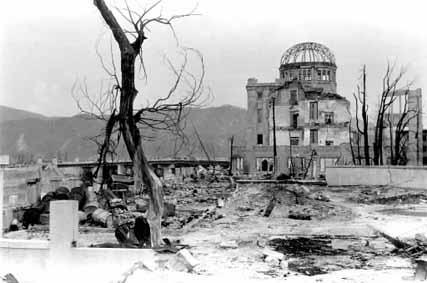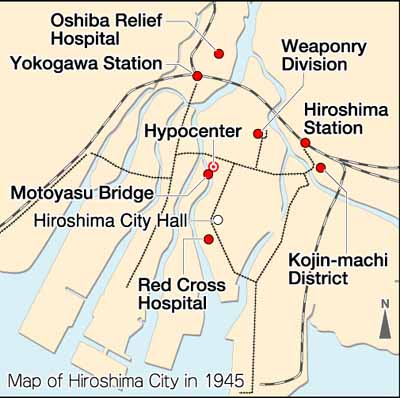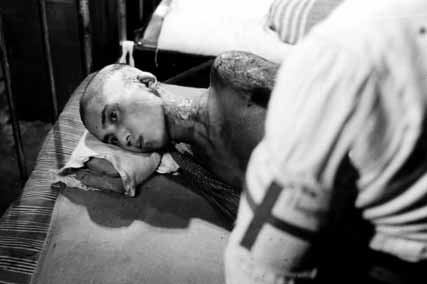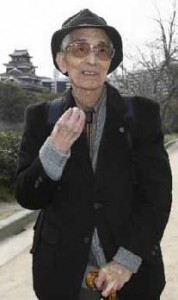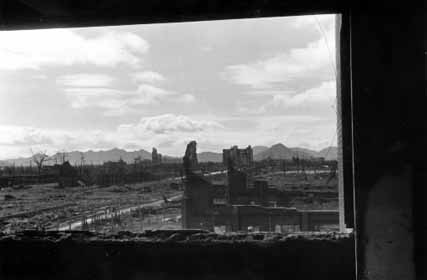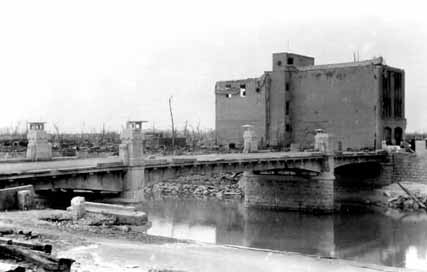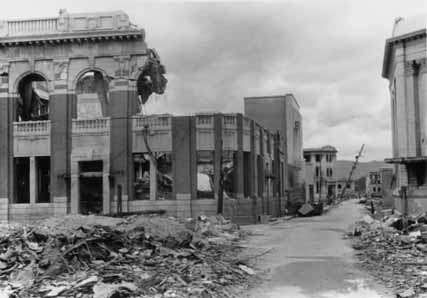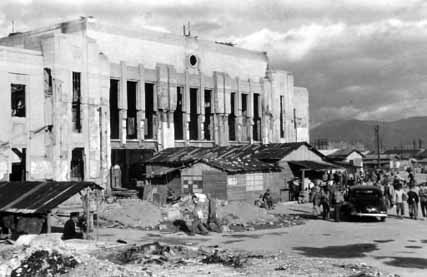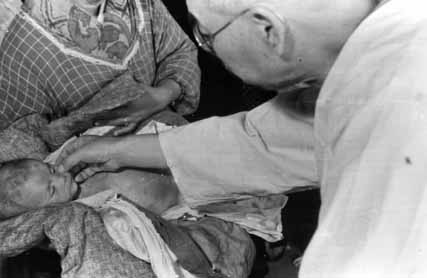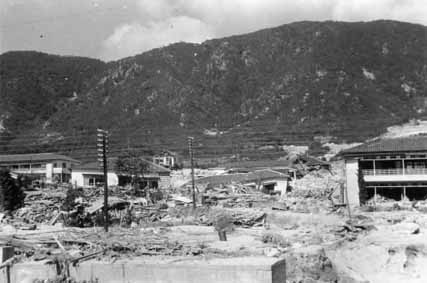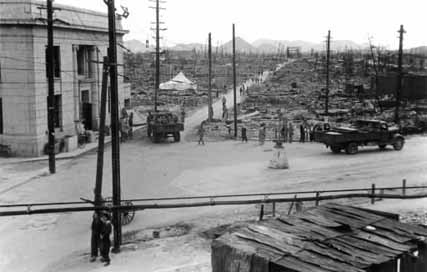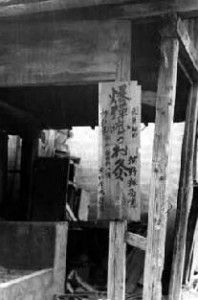- A-bomb Images
- The A-bomb Photographs of Shunkichi Kikuchi, Part Ⅲ: Tremendous Pain
The A-bomb Photographs of Shunkichi Kikuchi, Part Ⅲ: Tremendous Pain
by Masami Nishimoto, Senior Staff Writer
(Originally published on March 28, 2007)
Valuable photographs taken by Shunkichi Kikuchi, which recorded the devastation of the city in the aftermath of the atomic bombing, have been preserved in Hiroshima. Hiroshima Peace Memorial Museum and the Chugoku Shimbun have posted 860 photographs, with detailed captions, online and in other media after printing them from the original negatives. The two organizations gained the cooperation of Mr. Kikuchi’s wife, Tokuko, 82, now living in Tokyo, who possesses the original negatives. The Hiroshima International Cultural Foundation provided a grant to print 771 of the photographs from 35 millimeter negatives and 89 photographs from 6x6 centimeter negatives. All the images are clear and convey to the world the true impact of what occurred in Hiroshima on August 6, 1945.
In a document written years later, Mr. Kikuchi recalled his photographic work between October 1 and 20, 1945, when he accompanied a documentary film team assembled by the former Ministry of Education’s “Special Committee for the Investigation of A-bomb Damage.” His thoughts were recorded in a book entitled, “The Men Who Photographed the Atomic Bombing,” compiled by a group organized in 1982 called the “Anti-nuclear Photography Campaign.” Mr. Kikuchi was one of its founders.
In the book, Mr. Kikuchi wrote about a soldier in Hiroshima Red Cross Hospital. “I felt so sorry taking photographs of this man when he was in tremendous pain.” The man was suffering from terrible burns all over his body as well as acute radiation effects, including diarrhea.
The soldier was Tadataka Sasaki, 86, who is now a resident of Kure City in Hiroshima Prefecture. At the time, he was a member of the Chugoku Military District Weaponry Division in Hiroshima. He was exposed to the bomb near Hiroshima Castle, approximately 1 kilometer northeast of the hypocenter. Two days later, he was taken to an emergency relief center set up at the Fukuya Department Store. His wife and others managed to find him and carried him on a stretcher to Hiroshima Red Cross Hospital.
The patients were laid down in the hospital ward, packed together like sardines, and were given only brown rice in a bamboo container. Mr. Sasaki recalled that 40 to 50 patients died every day.
“I would have died, too, if my family had not cooked food for me by bringing pots into the hospital ward. Dr. Fumio Shigeto (then deputy director of the hospital and later the first director of the Atomic Bomb Survivors Hospital; he died in 1982) introduced me to the film crew as ‘a miraculous survivor’ so I ended up having my photograph taken for the film. I had to endure additional pain caused by the floodlights they used for filming. The pain was unbearable,” he recalled.
“In late October, I returned to the city of Takehara where I still live,” said Mr. Sasaki. “I thought to myself, if I have to die anyway, I want to die in my own house in my own hometown.” Mr. Sasaki recovered three years later under his wife’s care. His wife was also an A-bomb survivor who entered the area soon after the bombing. She died at the age of 39.
The documentary film about the atomic bomb produced by the Japan Film Corporation was seized by the U.S. military after it was completed. The film was returned to the Japanese Ministry of Education in 1967 and shown to the public at that time, but 13 minutes were cut because the long scenes of the “effects on the human body” were considered “too graphic.” The missing scenes were broadcast on nationwide television for the first time in 1970, after Mr. Sasaki confirmed that he appeared in the film. At that time, he was working for a financial institution and raising four children with his second wife.
It was not until he was close to 70 years old that Mr. Sasaki began to talk publicly about his experience of the bombing. He organized a group of A-bomb witnesses as part of the Kure Hibakusha (Survivors) Association. In addition to showing photographs of the keloid scars on his upper body, he photocopied prints from the documentary film--not knowing, at the time, that the original photographs still existed.
When Mr. Kikuchi’s photos finally returned to Hiroshima, Mr. Sasaki stared intently at his younger self in the images. The six photos showed Mr. Sasaki, a vacant look in his eyes, exposing his upper body to reveal his horrible burns. “I am too old now to go to Hiroshima and talk to students visiting the city on their school trips,” he said. “But I want everyone to know that atomic bombs kill innocent people.”
Mr. Kikuchi left a note that said, “Taking photos in the ruins, alongside the horror of invisible radiation, was frightening. Still, as a photographer, I felt compelled to record my surroundings.” Only by holding back his sorrow for the victims could he press the shutter of his camera and fulfill this mission of informing people of the consequences of the atomic bomb.
After the war, Mr. Kikuchi and other photographers published a collection of their work, entitled “Tokyo: Autumn 1945.” He became an independent photographer and took photos for scientific research and of rural communities in the mountainous areas of Japan. After becoming friends with Dr. Hideki Yukawa and Dr. Shinichiro Tomonaga, he made portraits of these two Nobel Prize Laureates in Physics who spoke out for the total abolition of nuclear weapons. His wife, Tokuko, shed further light on the nature of Mr. Kikuchi’s work by noting, “My husband always declined offers to make commercial advertisements and was never persuaded to change his mind.” Mr. Kikuchi passed away of leukemia at the age of 74.
Related articles
The A-bomb Photographs of Shunkichi Kikuchi, Part I: 783 Negatives Return to Hiroshima
The A-bomb Photographs of Shunkichi Kikuchi, Part II: Images from Hiroshima Red Cross Hospital
Panoramic photos found of Hiroshima's reconstruction (Jan. 18, 2008)
(Originally published on March 28, 2007)
Valuable photographs taken by Shunkichi Kikuchi, which recorded the devastation of the city in the aftermath of the atomic bombing, have been preserved in Hiroshima. Hiroshima Peace Memorial Museum and the Chugoku Shimbun have posted 860 photographs, with detailed captions, online and in other media after printing them from the original negatives. The two organizations gained the cooperation of Mr. Kikuchi’s wife, Tokuko, 82, now living in Tokyo, who possesses the original negatives. The Hiroshima International Cultural Foundation provided a grant to print 771 of the photographs from 35 millimeter negatives and 89 photographs from 6x6 centimeter negatives. All the images are clear and convey to the world the true impact of what occurred in Hiroshima on August 6, 1945.
In a document written years later, Mr. Kikuchi recalled his photographic work between October 1 and 20, 1945, when he accompanied a documentary film team assembled by the former Ministry of Education’s “Special Committee for the Investigation of A-bomb Damage.” His thoughts were recorded in a book entitled, “The Men Who Photographed the Atomic Bombing,” compiled by a group organized in 1982 called the “Anti-nuclear Photography Campaign.” Mr. Kikuchi was one of its founders.
In the book, Mr. Kikuchi wrote about a soldier in Hiroshima Red Cross Hospital. “I felt so sorry taking photographs of this man when he was in tremendous pain.” The man was suffering from terrible burns all over his body as well as acute radiation effects, including diarrhea.
The soldier was Tadataka Sasaki, 86, who is now a resident of Kure City in Hiroshima Prefecture. At the time, he was a member of the Chugoku Military District Weaponry Division in Hiroshima. He was exposed to the bomb near Hiroshima Castle, approximately 1 kilometer northeast of the hypocenter. Two days later, he was taken to an emergency relief center set up at the Fukuya Department Store. His wife and others managed to find him and carried him on a stretcher to Hiroshima Red Cross Hospital.
The patients were laid down in the hospital ward, packed together like sardines, and were given only brown rice in a bamboo container. Mr. Sasaki recalled that 40 to 50 patients died every day.
“I would have died, too, if my family had not cooked food for me by bringing pots into the hospital ward. Dr. Fumio Shigeto (then deputy director of the hospital and later the first director of the Atomic Bomb Survivors Hospital; he died in 1982) introduced me to the film crew as ‘a miraculous survivor’ so I ended up having my photograph taken for the film. I had to endure additional pain caused by the floodlights they used for filming. The pain was unbearable,” he recalled.
“In late October, I returned to the city of Takehara where I still live,” said Mr. Sasaki. “I thought to myself, if I have to die anyway, I want to die in my own house in my own hometown.” Mr. Sasaki recovered three years later under his wife’s care. His wife was also an A-bomb survivor who entered the area soon after the bombing. She died at the age of 39.
The documentary film about the atomic bomb produced by the Japan Film Corporation was seized by the U.S. military after it was completed. The film was returned to the Japanese Ministry of Education in 1967 and shown to the public at that time, but 13 minutes were cut because the long scenes of the “effects on the human body” were considered “too graphic.” The missing scenes were broadcast on nationwide television for the first time in 1970, after Mr. Sasaki confirmed that he appeared in the film. At that time, he was working for a financial institution and raising four children with his second wife.
It was not until he was close to 70 years old that Mr. Sasaki began to talk publicly about his experience of the bombing. He organized a group of A-bomb witnesses as part of the Kure Hibakusha (Survivors) Association. In addition to showing photographs of the keloid scars on his upper body, he photocopied prints from the documentary film--not knowing, at the time, that the original photographs still existed.
When Mr. Kikuchi’s photos finally returned to Hiroshima, Mr. Sasaki stared intently at his younger self in the images. The six photos showed Mr. Sasaki, a vacant look in his eyes, exposing his upper body to reveal his horrible burns. “I am too old now to go to Hiroshima and talk to students visiting the city on their school trips,” he said. “But I want everyone to know that atomic bombs kill innocent people.”
Mr. Kikuchi left a note that said, “Taking photos in the ruins, alongside the horror of invisible radiation, was frightening. Still, as a photographer, I felt compelled to record my surroundings.” Only by holding back his sorrow for the victims could he press the shutter of his camera and fulfill this mission of informing people of the consequences of the atomic bomb.
After the war, Mr. Kikuchi and other photographers published a collection of their work, entitled “Tokyo: Autumn 1945.” He became an independent photographer and took photos for scientific research and of rural communities in the mountainous areas of Japan. After becoming friends with Dr. Hideki Yukawa and Dr. Shinichiro Tomonaga, he made portraits of these two Nobel Prize Laureates in Physics who spoke out for the total abolition of nuclear weapons. His wife, Tokuko, shed further light on the nature of Mr. Kikuchi’s work by noting, “My husband always declined offers to make commercial advertisements and was never persuaded to change his mind.” Mr. Kikuchi passed away of leukemia at the age of 74.
Related articles
The A-bomb Photographs of Shunkichi Kikuchi, Part I: 783 Negatives Return to Hiroshima
The A-bomb Photographs of Shunkichi Kikuchi, Part II: Images from Hiroshima Red Cross Hospital
Panoramic photos found of Hiroshima's reconstruction (Jan. 18, 2008)

